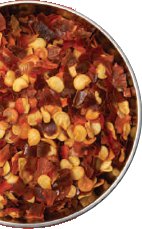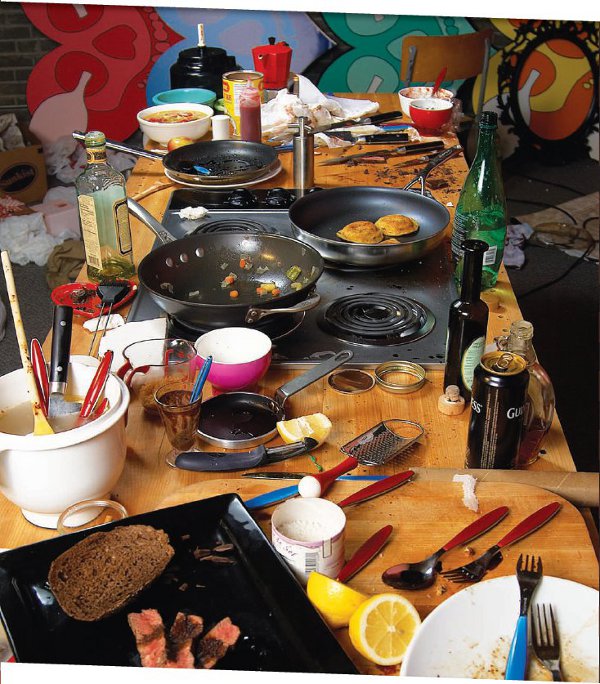The Bitchin’ Basics
ORGANIC INGREDIENTS
Always try to get your hands on organic-certified ingredients. Don’t get me wrong, this isn’t a hippie cookbook, but I’m a firm believer that you shouldn’t put anything in your mouth that’s chock-full of sketchy hormones, antibiotics, or chemicals (past the age of 19.) Almost all cities have a farmer’s market and this is where the best ingredients are found. But beware, just because you’re at the farmer’s market doesn’t mean everything is organic, so if you’re not sure, ask.
I know it’s not easy to eat 100% organic, so if I had to put my foot down on certain ingredients it would be the meat. Never cook with *cac meat. But you probably won’t listen to me, so…
BURGER STINK JUICE
Sometimes the ground beef you find at the grocery store isn’t top-notch, and when you sauté it you notice a watery liquid at the bottom of the pan. This liquid smells like a cross between expired margarine and death. Strain this liquid, keep cooking the beef, then strain some more until it’s all gone. Or better yet, listen to me and only buy fresh organic beef from a certified butcher.
OLIVE OIL
There are three things you never want to be stingy about: sky-diving, plastic surgery, and olive oil. Since olive oil is found in almost every Mediterranean dish, don’t be penny-wise and pound foolish. Buy the best quality, cold-pressed, extra virgin olive oil you can afford, otherwise you’ll ruin a great meal. (I usually shell out between $15 and $25 for a 500 ml bottle of extra virgin.)
BUTTER
Don’t buy salted butter. You’re the master of your kitchen, so you control the salt. Also know that margarine isn’t a replacement for butter, it’s Satan’s lube. Not only is this crap nasty-tasting, it’s extremely unhealthy. Margarine is made from some of the the cheapest oils on earth, barely fit for human consumption. These scavenger oils are then processed with chemicals, bleached, deodorized, and finally dyed an “appetizing” yellow color. I can’t believe it’s not shoe polish.
DEGERMING GARLIC
Most garlic is shipped all the way from China and by the time it reaches the grocery store shelves it has already begun to germinate. This germ, located in the center of the clove, infests your recipes with a dark, overly-ripe garlic flavor that you’ll keep burping up for hours. Ideally you want to buy young organic garlic that has no germ. But whenever that’s not a possibility, abort the sucker.

PASTA & SAUCE
Pasta is best when you follow these steps: (1) Cook it al dente (about 8 to 10 minutes, depending on the kind of pasta). (2) Boil it in sufficiently salted water, about as salty as you like your soup. (3) Once the pasta is cooked, strain it, pour it into a big bowl and mix it with a ladleful of sauce so every strand absorbs some saucy goodness. (4) Go easy on the sauce. You’re supposed to be tasting the pasta and highlighted ingredients, not tomato soup. Two to three tablespoons of sauce is enough for 1 cup of cooked pasta.
ADDING SPICES
Cooking is a tactile experience for me and I quantify by using big or small *pinches. By running the spices between my fingertips I feel the perfect amount (gawd, we all turn into our mothers don’t we?) This takes practice, so if you’re new to the kitchen remember that less is more. You can always add salt and spice if it’s too bland, but you can’t take any away, so be careful. (If you really need specific instructions, know that a small pinch is about ¼ of a teaspoon. A big pinch is about ½ a teaspoon.)
SEA SALT & FRESHLY CRACKED PEPPER
I always use sea salt in my recipes, it’s more subtle and natural than table salt. Table salt has weird-ass additives like sodium silicoaluminate and alumnio-calcium silicate. The general rule is: if you can’t pronounce it and it’s in your own language, don’t eat it. When it comes to peppering your dishes, there’s no substitute for freshly cracked pepper. Precracked pepper sits around in the open for too long and by the time it hits your plate it’s lost 99 percent of its flavor. Useless.
SUGAR
Stay away from refined (bleached) sugar. Personally, I don’t even know why they still carry this crap on the shelves. Bleached products come from a time where a bunch of nerdy white dudes got overly-excited by the industrial revolution and messed around with perfectly good ingredients just so they could feel omnipotent at any cost, even our health. (Don’t even get me started on tampons…) White isn’t “pure,” it’s dangerous.
OK! So it’s best to use brown sugar, raw cane sugar, honey, or molasses to sweeten your dishes. These darker, more natural sugars don’t only add sweetness, they add flavor—and flavor is always good.
CINNAMON
Never buy cinnamon in powdered form. That stuff is the anthrax of the spice world, just one airborne pinch and it’s all over! Everything will be infected with the smell of cinnamon: other spices, cereals, pastas… even your soul. Buy cinnamon in sticks, grate them only when needed, and then store them in an airtight, bulletproof safe, two feet underground in the backyard.
NEWBIES
If you’re a real newbie, then turn to page 190 for everything you need to get started. From how to stock a fridge, to essential cooking gear, to spice rack must-haves, I’ve got you covered.
